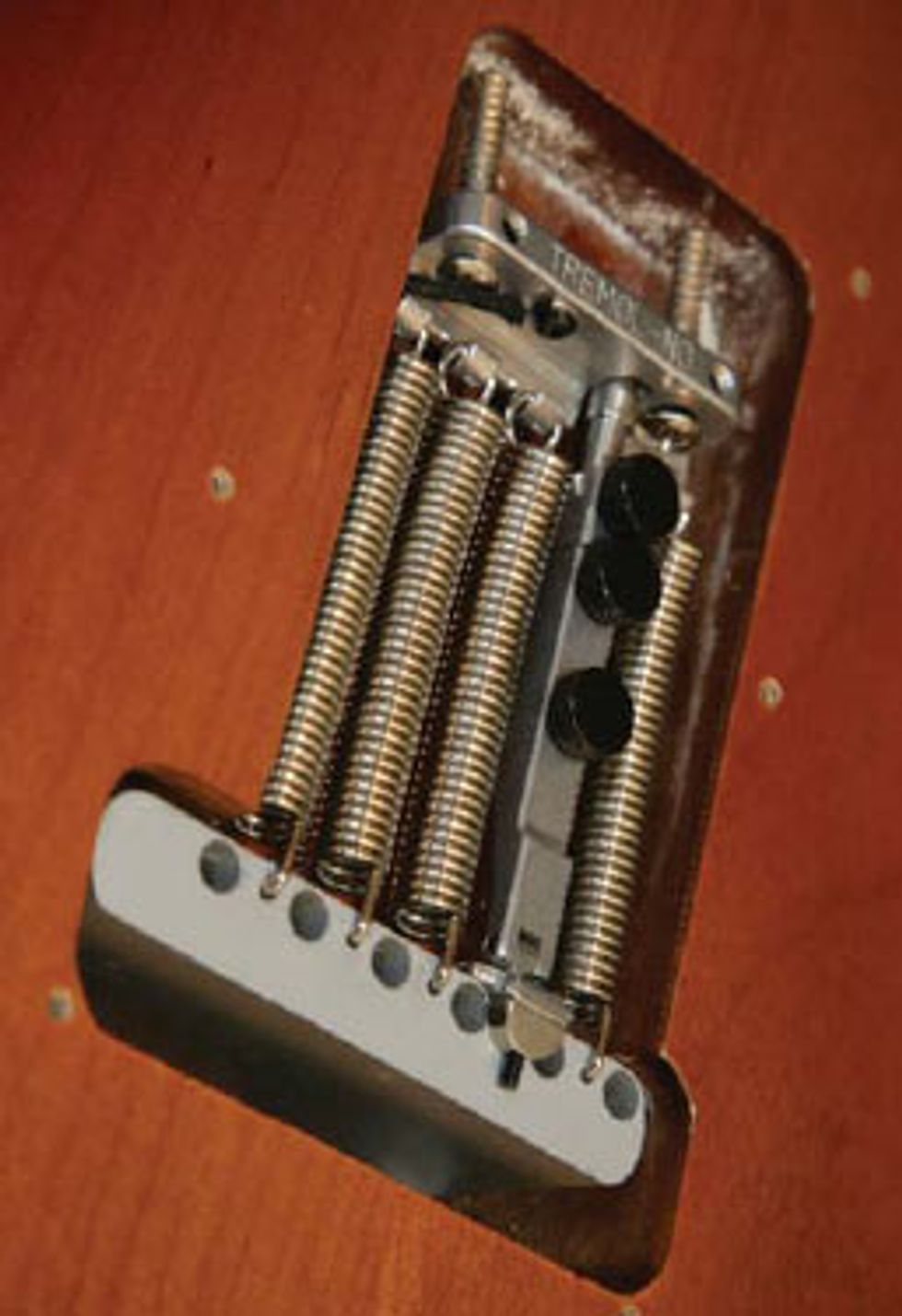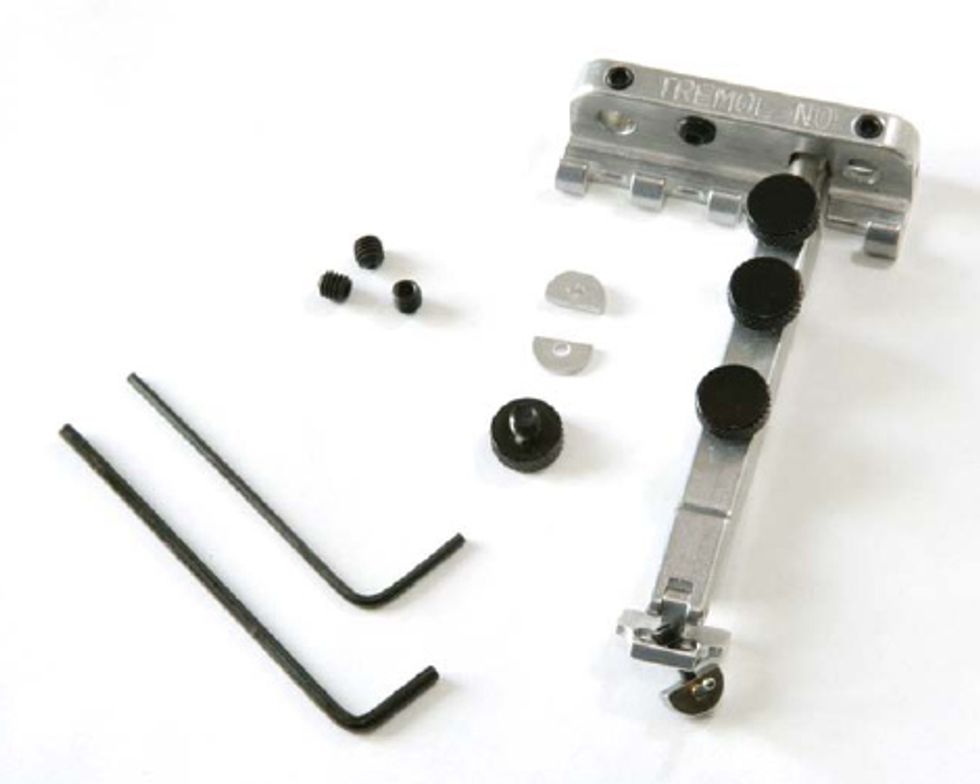 | |
| Download Example 1 | |
Most aftermarket tremolos are geared to keep the guitar in tune while maneuvers are performed on the whammy bar. And while the Tremol-No can be used with systems such as the Floyd Rose, its purpose is quite different. The Tremol-No is designed to lock the tremolo in place, preventing it from moving entirely. In just seconds, the Tremol- No can convert any Strat-type tremolo bridge to a solid bridge. It does this with an ingenious yet simple arrangement of a claw/ shaft assembly, and a receiver tailpiece.
The two types of people who would want the Tremol-No are those who don’t use tremolo very often (they dislike the tuning artifacts it induces but love the Strat’s tone), and those who do use the wiggle stick, but not on every song. If that sounds like it covers pretty much everybody who plays a Strat, you’ve got the right idea. I consider myself in the first group, so when the Tremol-No came to my attention, I had to try one out. At just $70 from allparts. com, and with the promise of no permanent disfigurement to my Strat, it was an experiment I could justify.
How It Works
At the heart of the matter is the equilibrium between the strings and the tremolo springs. At times, tuning even one string can result in the rest of the instrument going out of tune. Consider a gig scenario where you need to quickly tune the low E to a drop D; working tremolos generally—locking or not—aren’t really designed to keep the instrument in tune. Another scenario is a unison bend, where the unbent string drops in pitch as the other is bent up. The usual solution is to crank the screws holding the spring claw in the tremolo cavity, bottoming the bridge plate on the guitar body and effectively making it a solid bridge.
The Tremol-No dispenses with this, allowing the player to change between vibrato enabled and a solid bridge at will via two thumbscrews on the unit. It takes just seconds to go from locked to unlocked, and the inventor’s intent is that it can be operated on stage. Additionally, a third set screw locks and unlocks a block—called “deep C” by the Tremol-No’s makers—that acts as a bridge hard stop. That gives the Tremol-No three modes: completely locked down with no wiggle-stick action, hard stopped for dive-bomb action only, and totally unlocked for pitch-up and pitchdown movement.
It was a pleasant surprise that the installation took just half an hour. If you’ve got the dexterity to play guitar, then you’re qualified to install the Tremol-No. On a scale of one to five, it gets a five for ease of installation. This involves removing the trem cavity cover, removing the trem springs, unscrewing the spring claw, and replacing it with the Tremol-No claw assembly. No drilling, routing, or cutting is required. All you need is a screwdriver and a soldering iron. The kit even includes the two Allen wrenches you need to finish the install. (You won’t need them to operate the Tremol-No.)

The Proof Is In the Playing
Our unit was installed on a Fender Kenny Wayne Shepherd Artist Series Strat, which is a straightforward copy of Shepherd’s ’61. The Tremol-No worked as advertised, stopping down the vibrato action when fully locked, and restoring motion when unlocked. The “deep-C” stop also worked as promised; both locked modes requiring way more force on the whammy bar to overcome than we could muster. The Tremol-No is mechanically tough, and can take abuse. One of the unanticipated benefits of the Tremol-No is more sustain (with the Tremol- No fully locked).
Three things prevent the Tremol-No from scoring higher. When unlocked, the small set knobs are loose, and can work their way out—especially if you play aggressively. (The Tremol-No kit actually includes an extra knob for this reason.) We also noticed a buzzing in the tremolo cavity, but only when the Tremol-No was unlocked, most likely from the loosened set screws. Lastly, the Tremol-No mechanism sticks out above the flat surface of the body, which isn’t a big deal, since the cover plate has to remain off if you expect to lock and unlock the Tremol-No. The problem is that the thumb screws are exposed to your clothing, which can inadvertently unscrew them when the Tremol-No is unlocked.
The Final Mojo
For this player, the Tremol-No is a strong recommendation. The rock-stable tuning, extra sustain, and the ability to rest my hand on the bridge without wobbly pitch artifacts was a plus. Being able to execute unison and double-stop bends without the detuning was also nice. If, however, you gig heavily and perform lots of on-stage acrobatics with the whammy bar, you might get frustrated by the loose thumb screws dropping out. Just buy a box of extra thumbscrews for the Tremol-No. Stick ‘em in your gig bag, and you’ll be set.
Buy if...
you want a stage-friendlier tremolo solution, or if you want more sustain.
Skip if...
you're a purist and prefer the tremolo cover on, and you dig the damped sustain of a stock Strat.
Rating...
Street $70 - Tremol-No - tremol-no.com |






![Rig Rundown: Russian Circles’ Mike Sullivan [2025]](https://www.premierguitar.com/media-library/youtube.jpg?id=62303631&width=1245&height=700&quality=70&coordinates=0%2C0%2C0%2C0)

















